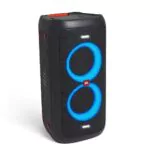Dueling Party Speakers: JBL PartyBox 100/310 review

Music is an essential aspect of any party, and having the right speaker system is crucial to create an energetic and enjoyable atmosphere. The JBL PartyBox series is a line of powerful and dynamic speakers designed specifically for party animals. In this review, we will take a closer look at two of the most popular models in the series – the JBL PartyBox 100 and 310. We will compare both products based on different categories such as product description, general specifications, audio specifications, control and connection specifications, battery, features, and price.
1 A detailed comparison between JBL PartyBox 100 vs 310
Product Description
The JBL PartyBox 100 and 310 are both rectangular-shaped speakers with a handle at the top for easy transportation. The PartyBox 100 is a smaller and lighter version, weighing just 9.7 kg, while the PartyBox 310 is more substantial, weighing 17.42 kg. Both models feature durable plastic construction with a metal grille covering the speakers, ensuring they can withstand bumps and knocks during transportation.
The front of the speakers is where the party magic happens, with built-in LED lights that change color and pulsate to the beat of the music. The PartyBox 310 has more extensive LED lighting, covering the entire front panel, while the PartyBox 100 has a smaller LED strip at the top. The LED lights add to the party atmosphere and can be customised to suit different moods and events.
One unique design element of the PartyBox 310 is the inclusion of a telescopic handle and wheels, making it easier to move around. This feature is especially useful for those who frequently host outdoor events or need to transport the speaker over long distances.
General Specifications
The JBL PartyBox 100 and 310 have a range of similar general specifications. Both models have Bluetooth connectivity, making it easy to stream music wirelessly from any device. They also have USB, RCA, and 3.5mm aux-in inputs, allowing you to connect to a wide range of devices. The PartyBox 310 has the added advantage of a guitar input and microphone input, making it ideal for karaoke sessions or live performances.
Audio Specifications
When it comes to audio performance, both the JBL PartyBox 100 and 310 deliver impressive sound quality, with powerful bass and clear vocals. The PartyBox 310 has two 6.5-inch woofers and two 2.25-inch tweeters, while the PartyBox 100 has a 12-inch woofer and a 1.5-inch tweeter. The PartyBox 310 has a more extensive frequency range, from 45 Hz – 20 kHz (-6 dB), while the PartyBox 100’s frequency range is 45Hz to 18kHz.
In terms of audio specifications, the JBL PartyBox 310 has a higher output power of 240W compared to the PartyBox 100’s 160W. This means that the PartyBox 310 delivers louder and more powerful sounds than the PartyBox 100. The two extra woofers and tweeters in the PartyBox 310 deliver a more immersive and powerful sound, making it ideal for large gatherings and outdoor events. However, the PartyBox 100 still delivers excellent sound quality and is more than enough for smaller parties or indoor events. If you’re looking for a speaker with greater audio output and a more immersive party experience, the PartyBox 310 may be the better choice. However, if you’re looking for a more compact and affordable option with decent audio output, the PartyBox 100 is still a great choice.
Control and Connection Specifications
Considering the control and connection specifications, the JBL PartyBox 310 has a more advanced Bluetooth version, 5.1, while the PartyBox 100 has an older Bluetooth version, 4.2. This means that the PartyBox 310 provides a more stable and reliable wireless connection compared to the PartyBox 100. Bluetooth 5.1 also offers faster data transfer speeds, lower latency, and better battery life compared to Bluetooth 4.2. Therefore, if you’re looking for a more seamless and hassle-free Bluetooth connection, the PartyBox 310 may be the better option.
Battery
When it comes to battery life, the JBL PartyBox 310 outperforms the PartyBox 100 with a maximum playtime of 18 hours compared to the PartyBox 100’s 12 hours. Additionally, the PartyBox 310 has a faster charging time of 3.5 hours, while the PartyBox 100 takes 6.5 hours to charge fully. This means that the PartyBox 310 provides longer music playback time and requires less time to charge, making it more convenient for longer events or parties where a power source may not be readily available.
Features
The JBL PartyBox 100 and 310 have several unique features that make them stand out in the party speaker market. One of these features is the PartyBox app, which allows you to control the speakers remotely and customise the LED lights. The app also enables you to access EQ settings and adjust the bass and treble to your liking.
Another feature of the PartyBox 100 and 310 is the ability to use them as a power bank to charge other devices. This feature is useful for those who need to charge their phones or tablets during a party or event.
Price
When it comes to price, the JBL PartyBox 310 is significantly more expensive than the PartyBox 100. The PartyBox 100 is priced at around ₹25,999, while the PartyBox 310 is priced at around ₹45,999. The price difference is due to the PartyBox 310’s larger size, more extensive LED lighting, and additional features such as guitar and microphone inputs.
2 Wrapping Up
To summarise, the JBL PartyBox 100 and 310 are both excellent party speakers with their unique features and advantages. The PartyBox 100 is a more affordable option, ideal for smaller gatherings and indoor events. It has a built-in battery, making it more portable and easier to use without needing to be near a power outlet. The PartyBox 310, on the other hand, is more substantial and has a more extensive LED lighting system, making it perfect for outdoor events and large gatherings. It also has additional features, such as guitar and microphone inputs, making it ideal for live performances and karaoke sessions.
Community Q&A
About This Article
This article has been viewed 585 times.





